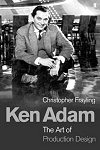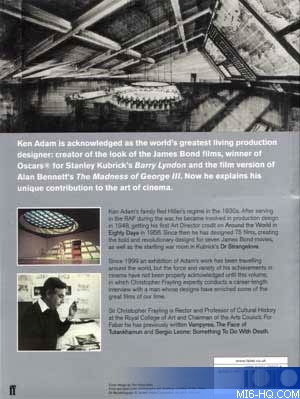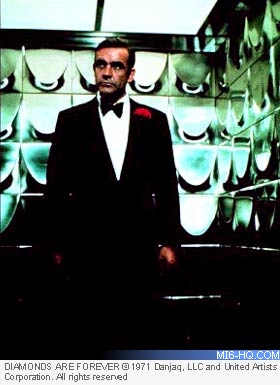|
|
|
 |
| |
MI6 looks at Sir Ken Adam's book in detail with a
double feature examining his work and memories from
Diamonds Are Forever...
|
|
Ken Adam: The Art of Production Design
- Diamonds Are Forever (1)
7th May 2006
Following on from the chapter on Chitty Chitty Bang Bang, Sir
Ken Adam reflects on his work on Connery's last official James Bond
film "Diamonds Are Forever". MI6 brings you an extract from the acclaimed
production designer's book by Sir Christopher Fraying, "Ken Adam
The Art of Production Design".
| Diamonds Are Forever
Then in 1971 you worked on the next Bond film, Diamonds
Are Forever. The big controversy surrounding this film
was that everybody thought it was going to be made in America,
and without Sean Connery.
They even cast an actor called John Gavin, who later became
- I think - the American Ambassador to Mexico for Ronald
Reagan.
John was very good-looking. Yes, he'd appeared in Psycho
and Spartacus.
But eventually a deal was struck with Sean Connery
and the movie shifted back to England. That must have been
quite nerve-racking.
Yes, it was nerve-racking. It was also interesting in a
way because it was my first experience of working in Hollywood,
and because Harry
Saltzman owned Technicolor at the time, which was part
of Universal, we were VIP visitors at Universal Studios.
It was still run like the old classic film studios: the
art department had a pool of over a hundred assistants,
like sketch artists, and the production designer wasn't
allowed to do his own sketches; the illustrators did all
that for him.
They had the most professional staff who were
under contract to Universal and had worked there for years
and years, happy to be either an illustrator or draughtsman.
The chief art director - the equivalent of Cedric Gibbons
- was Alex Golitzen. I found myself in a tiny office without
a window so I said to Alex, `I'm sorry, but I can't work
like this. I need a window.' He said they had twenty art
directors working like this. But we had muscle, so Alex
gave me the only office with a window. The block was called
the Black Tower. In fact, it's still called that. I also
got the best team from the art department to work for me.
Boris Leven, who I was very friendly with, advised me who
to use for the Bond movie. So it worked pretty well. Around
this time Cubby,
who was a friend of Howard Hughes, had the idea of doing
a spoof in a way of the Howard Hughes persona.
|
|

Above: Book cover art
Book Data Stream
Paperback 320 pages
Publisher: Faber and Faber
ISBN: 0571220576
 UK
Order
UK
Order
 USA
Order
USA
Order
|
Then the disasters struck. The first was whilst Herbert Ross
and Nora Kaye - great friends of ours and I'd done some pictures
with them - were doing a film in Chicago, they lent Letizia and
I their house in Beverly Hills and one morning at six o'clock
we woke up and everything was rattling. Letizia said, `Terremoto,'
which means `Earthquake'. I'd never been in an earthquake before.
Then suddenly everything started going wrong: books fell out of
the shelves, the television fell over, the swimming pool overflowed
like a saucer. And when we got outside, the palm trees were swaying
dangerously. I got a phone call from my sister in London who'd
heard on the BBC that an earthquake in Los Angeles had been measured
at 7.3 on the Richter scale. I was organising breakfast and trying
to get the maid to clear up the mess when the doorbell rang, and
there was Harry and Jackie Saltzman. They had been staying in
the penthouse suite at the Beverly Wiltshire Hotel and she had
grabbed her mink coat and jewels but not much else. Then Guy
Hamilton arrived with his wife Kerima. They were staying in
an apartment on La Cienaga on the twenty-sixth floor and the block
was designed to sway eight or nine feet at that height; can you
imagine?! I don't think Kerima ever fully recovered from the shock.
And lastly there was an Italian screenwriter who arrived clutching
a photograph of his mother! So we became like a refugee camp.
That was the fun of it. And in my stupidity I thought, `Well,
an earthquake is an earthquake. It's over. There are no aftershocks.'
So I drove to the studios - everybody said I was crazy - but there
was nobody there. I got into my office and all my sketches had
been blown all over the place. It was a very modern block; we
used magnetic tape to attach our sketches to the steel walls,
rather than drawing pins. But now the magnets didn't work. I couldn't
get hold of anybody on the telephone. And some of the freeway
had collapsed. So I decided to drive back. It was quite a traumatic
experience, but I can see the funny side of it now. We carried
on planning the film at Universal Studios and also in Las Vegas.

Above: Back cover |
|
For the moon buggy?
Yes, the moon buggy.
And a very important car chase for which Harry had discovered
these French stunt drivers who were able to flip a car on
its side and drive like that. I learnt a lot because Ford
provided all the cars and they had to be properly ballasted
to do this stuff. Basically we all had a very good time,
but I remember Dave Chasman, who was pretty high up in the
UA hierarchy, came to Universal one morning and said, `You're
crazy to do this film with John Gavin.' Dave knew we were
paying Gavin nothing in comparison to the two million dollars
that Sean Connery wanted, if I remember rightly, but he
said we could recoup that money with EADY Money, which was
a tax shelter in England.
In effect, a grant.
So, to cut a long story short, Sean got the film. We were
going to shoot the scenes that we had already set up like
the Las Vegas sequence, the oilrig in Santa Barbara, the
car chase ...
The moon buggy in a gypsum mine close to Las Vegas
...
Yes. Shoot all that there and then film the interiors and
other sets in Pinewood. This was decided late in the day.
For me it was a gigantic logistical problem because I had
nobody from the British Bond team with me. So I rang Peter
Lamont, who was fortunately available to fly out and liaise
with the American art department, and then set up an art
department in Pinewood for when I got back.
|
The moon buggy picked up on the real one we'd recently seen
on television from the moon shot - as ever, reflecting things
that were in the news and extending them.
That was not my idea. Guy Hamilton decided that it should look
grotesque so I extended the mechanical arms. I copied the fibreglass
conical wheels of the real moon buggy but they kept breaking at
high speed on the rough terrain of the moonscape we based on NASA
photographs, so eventually Sony gave me balloon tyres and we completed
the sequence with them. It was nearly a disaster. But Las Vegas
was a fascinating place.
| There's a great shot in the film -
that looks like a futuristic set but I think it's a real
location - of Bond standing in an exterior glass elevator
going up the side of a building. It seems almost science
fiction.
It's partly on location. There was a hotel that no longer
exists, The Sands maybe, and it was a bit like a tower with
one of these exterior glass elevators. I wanted to show
it to a, so I went to the hotel with my 16mm camera and
stepped into the elevator, but a security man told me I
couldn't shoot there.
I told Cubby and he made a call to
Howard Hughes who was living in a penthouse. Hughes apparently
said, `Don't worry about it. Get your production designer
back there and he'll get the VIP treatment.' So I went back
there and everybody was bowing and scraping to me. At the
time, half of Las Vegas belonged to Hughes and the other
half to various syndicates. Cubby even got me permission
to enter Hughes's ranch in Nevada, where the security guards
looked at me and said, `Are you Mr Hughes?' They had no
idea what he looked like!
|
|

|
By this time I think Hughes had a long beard, long unwashed
hair and very long fingernails.
It was amazing. Cubby was the only person who could get through
to him. I was present when he spoke to Hughes on the phone, but
I never met him. So Las Vegas was fascinating. The whole art department
was staying with me at a hotel that belonged to one of those syndicates
and it didn't cost us a cent. But the big problem was that nobody
went to bed. At four in the morning I found my chief draughtsman
- my assistant - in the casino. And there were so many beautiful
women. There were ten women to each man.
Stay tuned to MI6 for the final extract
from Sir Christopher Frayling's book Ken Adam: The Art of Production
Design.
Related Articles
 Ken Adam: The Art of Production
Design - Preview
Ken Adam: The Art of Production
Design - Preview
 Thunderball
40th Anniversary Pictures Thunderball
40th Anniversary Pictures
 Thunderball
40th Anniversary Event Report Thunderball
40th Anniversary Event Report
 Dr.
No Production Notes Dr.
No Production Notes
 Goldfinger
Production Notes Goldfinger
Production Notes
 Thunderball
Production Notes Thunderball
Production Notes
 You
Only Live Twice Production Notes You
Only Live Twice Production Notes
 Diamonds
Are Forever Production Notes Diamonds
Are Forever Production Notes
 Live
And Let Die Production Notes Live
And Let Die Production Notes
 The
Spy Who Loved Me Production Notes The
Spy Who Loved Me Production Notes
 Moonraker
Production Notes Moonraker
Production Notes
 Goldeneye
Rogue Agent Goldeneye
Rogue Agent
Many thanks to Faber & Faber, Sir Christopher
Frayling and Sir Ken Adam.
|
|
|